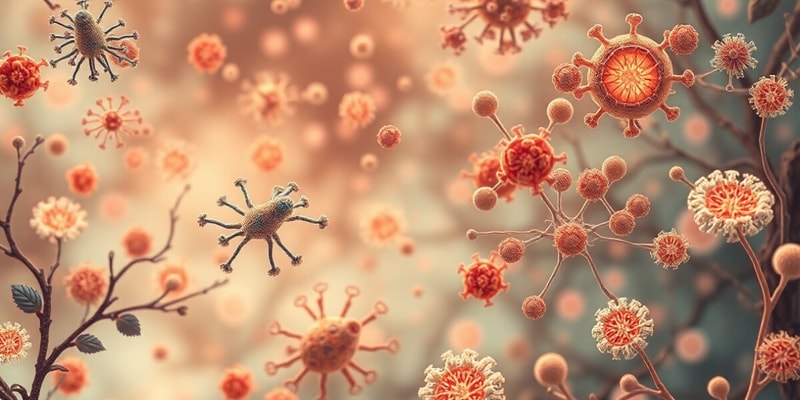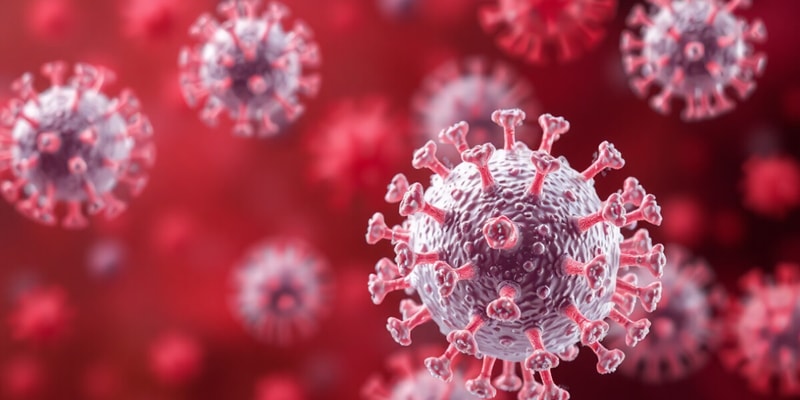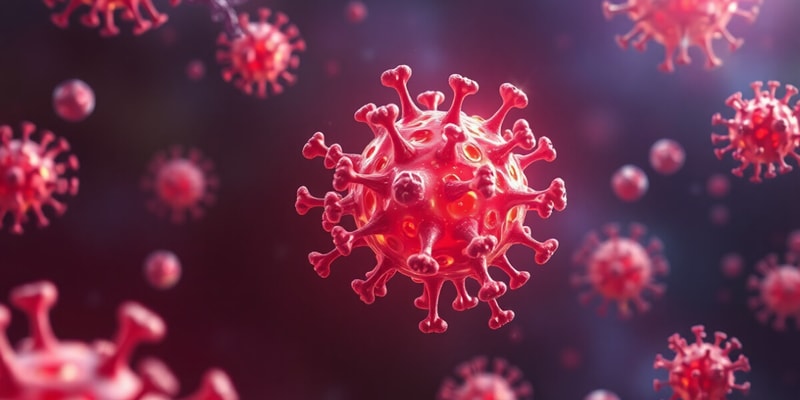Podcast
Questions and Answers
Which immunoglobulin is primarily involved in allergic reactions and binds to mast cells and basophils?
Which immunoglobulin is primarily involved in allergic reactions and binds to mast cells and basophils?
What percentage of the total immunoglobulin pool does IgD represent?
What percentage of the total immunoglobulin pool does IgD represent?
Which immunoglobulin is predominant in secretions such as tears and saliva?
Which immunoglobulin is predominant in secretions such as tears and saliva?
What is the role of the Fc region of an antibody?
What is the role of the Fc region of an antibody?
Signup and view all the answers
Which immunoglobulin has a pentameric form, making it a potent agglutinating antibody?
Which immunoglobulin has a pentameric form, making it a potent agglutinating antibody?
Signup and view all the answers
What is the primary function of secretory IgA?
What is the primary function of secretory IgA?
Signup and view all the answers
Which immunoglobulin mainly functions as a receptor on B cells?
Which immunoglobulin mainly functions as a receptor on B cells?
Signup and view all the answers
Which component of the antibody is responsible for binding to the antigen?
Which component of the antibody is responsible for binding to the antigen?
Signup and view all the answers
What differentiates immunogens from antigens?
What differentiates immunogens from antigens?
Signup and view all the answers
Which statement about antibodies is correct?
Which statement about antibodies is correct?
Signup and view all the answers
Which of the following describes epitopes?
Which of the following describes epitopes?
Signup and view all the answers
What role do antigens play in the immune response?
What role do antigens play in the immune response?
Signup and view all the answers
What type of substances can be classified as antigens?
What type of substances can be classified as antigens?
Signup and view all the answers
Why are antigens considered crucial for vaccine development?
Why are antigens considered crucial for vaccine development?
Signup and view all the answers
Which characteristic applies to immunogens but not to all antigens?
Which characteristic applies to immunogens but not to all antigens?
Signup and view all the answers
What is a common source of antigens?
What is a common source of antigens?
Signup and view all the answers
What type of cells present antigens in the MHC-II pathway?
What type of cells present antigens in the MHC-II pathway?
Signup and view all the answers
What is the unique characteristic of CD4+ T-cells?
What is the unique characteristic of CD4+ T-cells?
Signup and view all the answers
Which immunoglobulin class is most abundant in serum and plays a significant role in secondary immune responses?
Which immunoglobulin class is most abundant in serum and plays a significant role in secondary immune responses?
Signup and view all the answers
What describes the primary role of antibodies?
What describes the primary role of antibodies?
Signup and view all the answers
How do CD8+ T-cells primarily recognize altered self-cells?
How do CD8+ T-cells primarily recognize altered self-cells?
Signup and view all the answers
In the context of immunoglobulin classes, what does IgA primarily do?
In the context of immunoglobulin classes, what does IgA primarily do?
Signup and view all the answers
What defines CD8+ T-cells' role in the immune response?
What defines CD8+ T-cells' role in the immune response?
Signup and view all the answers
What is the function of TH cells within the immune system?
What is the function of TH cells within the immune system?
Signup and view all the answers
What is the concentration range of IgG in serum?
What is the concentration range of IgG in serum?
Signup and view all the answers
Which immunoglobulin is known for being the first to be synthesized in a primary immune response?
Which immunoglobulin is known for being the first to be synthesized in a primary immune response?
Signup and view all the answers
Which statement accurately describes the structure of IgM?
Which statement accurately describes the structure of IgM?
Signup and view all the answers
What role does IgE play in the immune system?
What role does IgE play in the immune system?
Signup and view all the answers
Which of the following statements about IgG is true?
Which of the following statements about IgG is true?
Signup and view all the answers
What characteristic of IgM contributes to its effective complement activation?
What characteristic of IgM contributes to its effective complement activation?
Signup and view all the answers
The multimeric nature of IgA is primarily important for which function?
The multimeric nature of IgA is primarily important for which function?
Signup and view all the answers
What is a common structure feature of all immunoglobulins?
What is a common structure feature of all immunoglobulins?
Signup and view all the answers
Which type of bond is characterized by the formation of hydrogen bridges between appropriate atoms?
Which type of bond is characterized by the formation of hydrogen bridges between appropriate atoms?
Signup and view all the answers
What type of force arises from the interaction between electron clouds and hydrophobic bonds?
What type of force arises from the interaction between electron clouds and hydrophobic bonds?
Signup and view all the answers
What strengthens the bonding between antigens and antibodies?
What strengthens the bonding between antigens and antibodies?
Signup and view all the answers
What is the primary characteristic of monoclonal antibodies?
What is the primary characteristic of monoclonal antibodies?
Signup and view all the answers
Which of the following techniques involves the combination of soluble antigen with soluble antibody to create visible complexes?
Which of the following techniques involves the combination of soluble antigen with soluble antibody to create visible complexes?
Signup and view all the answers
What is the main purpose of hemolysis testing?
What is the main purpose of hemolysis testing?
Signup and view all the answers
Which of the following accurately describes electrostatic forces?
Which of the following accurately describes electrostatic forces?
Signup and view all the answers
What does the agglutination process result in?
What does the agglutination process result in?
Signup and view all the answers
Study Notes
Antigens and Immunogens
- Antigens are foreign substances that stimulate an immune response and can bind to antibodies.
- All immunogens are antigens, but not all antigens are immunogens.
- Key to triggering responses is the foreignness of antigens, which can include components from bacteria, viruses, fungi, and protozoa.
- Example: Bacterial cell wall components are potent immunogens.
Antibodies
- Antibodies are Y-shaped proteins produced by B cells that specifically recognize and bind to antigens.
- Known as immunoglobulins, they play a crucial role in the humoral immune response.
- Antigenic determinants, or epitopes, are specific parts of an antigen recognized by antibodies, and multiple epitopes can exist on a single antigen.
T-cells
- Two main types of T-cells: Helper T-cells (TH) and Cytotoxic T-cells (TC).
- TH cells (MHC-II restricted) send signals through cytokines to other immune system cells.
- TC cells (MHC-I restricted) attack altered self-cells, such as infected cells.
Immunoglobulin Classes
- Five classes of immunoglobulins: IgG, IgM, IgA, IgE, and IgD, each having unique structures and functions.
- IgG is the most abundant immunoglobulin in serum, involved in secondary immune responses and crosses the placenta.
- IgM is the first antibody produced in a primary response and is pentameric in structure, crucial for agglutination and complement activation.
- IgA is predominantly found in mucosal areas and important for mucosal immunity, often in dimeric form.
- IgE binds to mast cells and basophils, playing a role in allergic reactions and immunity against parasites.
- IgD functions mainly as a receptor on B cells for activation.
Antibody Structure
- Antibodies consist of two heavy chains and two light chains, with distinct Fab and Fc regions.
- Fab region binds to the antigen, providing specificity, while Fc region mediates interactions with immune cells and effector functions.
- Goodness of fit in antibody-antigen bonding is optimized by proximity and complementary shapes.
Antigen-Antibody Reactions
- Various in-vitro tests detect antigen-antibody reactions:
- Agglutination: Particulate antigens aggregate in presence of specific antibodies.
- Precipitation: Combines soluble antigens with soluble antibodies to form visible insoluble complexes.
- Hemolysis testing: Measures cellular reactions to antigens and antibodies.
- ELISA: A method using enzyme-linked reactions for detection.
Monoclonal Antibodies
- Monoclonal antibodies (MAbs) are purified antibodies derived from a single cell clone, offering high specificity for antigens.
Studying That Suits You
Use AI to generate personalized quizzes and flashcards to suit your learning preferences.
Description
This quiz explores the concepts of antigens and antibodies, focusing on their roles as immunogens. Understand the distinction between antigens and immunogens, as well as the foreignness required for an immune response. Test your knowledge on how these substances interact within the immune system.




